The Purpose of an Informative Essay

An essay that does not persuade the audience to change their belief instead is interesting an informative.
Informative essay educate the person who reads about a subject or a theme. The reason of an informative essay, also called an expository essay, is to inform and teach on a definite topic. Informative essays are used for many purposes sometimes they compare view points for certain controversial issues, sometimes analyze data, and educate readers at other times.
For instance, if the writer wrote about his favorite uncle, he would be writing an informative/expository essay telling something about his uncle. Likewise, he wrote an essay giving directions for making a paper boat; he would still be writing an informative/expository essay giving directions.
Structure of an Informative Essay
The beginning of an Informative essay needs to introduce the subject, quotations, and snatch the attention of the audience. The definition of the topic that is being written about must be included.
The middle will be the major part of the Informative essay that contains all the main realities, evidences, ideas, facts, details etc. that is covered. This portion is where the audiences understand and receive all their questions answered.
The end is a result or conclusion where the essay will be summarized. It should incite the reader or listener to study more about the subject.
An informative essay may…
- explain things most readers won’t know
- define an intricate or difficult term
- present the up-to-the-minute investigation on a topic
- analyze a cause-effect liaison or relation
- compare and distinct conflicting perspectives
- teach readers in applying knowledge in solving a problem
Informative essays with creative ideas make the essay more inventive and inspiring or any writing for that matter, the right choice of words will help move smoothly from one idea to the next. Use anecdotes and little short stories create a picture developing interest with vivid description and details. Help the audience “see” as they read the essay. Give details where the subject will do action instead of being acted upon. Using strong image-making ACTION VERBS, instead of weak linking verbs, use vivid Adjectives and Adverbs with Figurative Language – similes, pun, metaphors etc. making the essay alive. Develops the subject with appropriate, facts and real details maintaining a realistically formal style.

Points to Remember
- Uses linking words and phrases to connect ideas
- Provides a concluding section related to the explanation presented
- Organizes complex ideas, concepts, and information to make important connections,
- maintains a formal style and objective tone while attending to norms and








